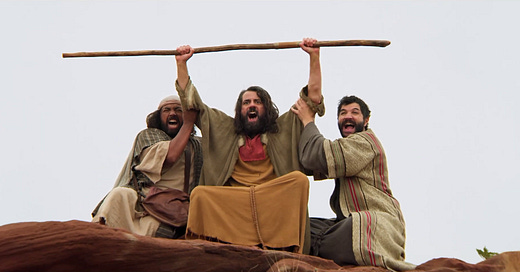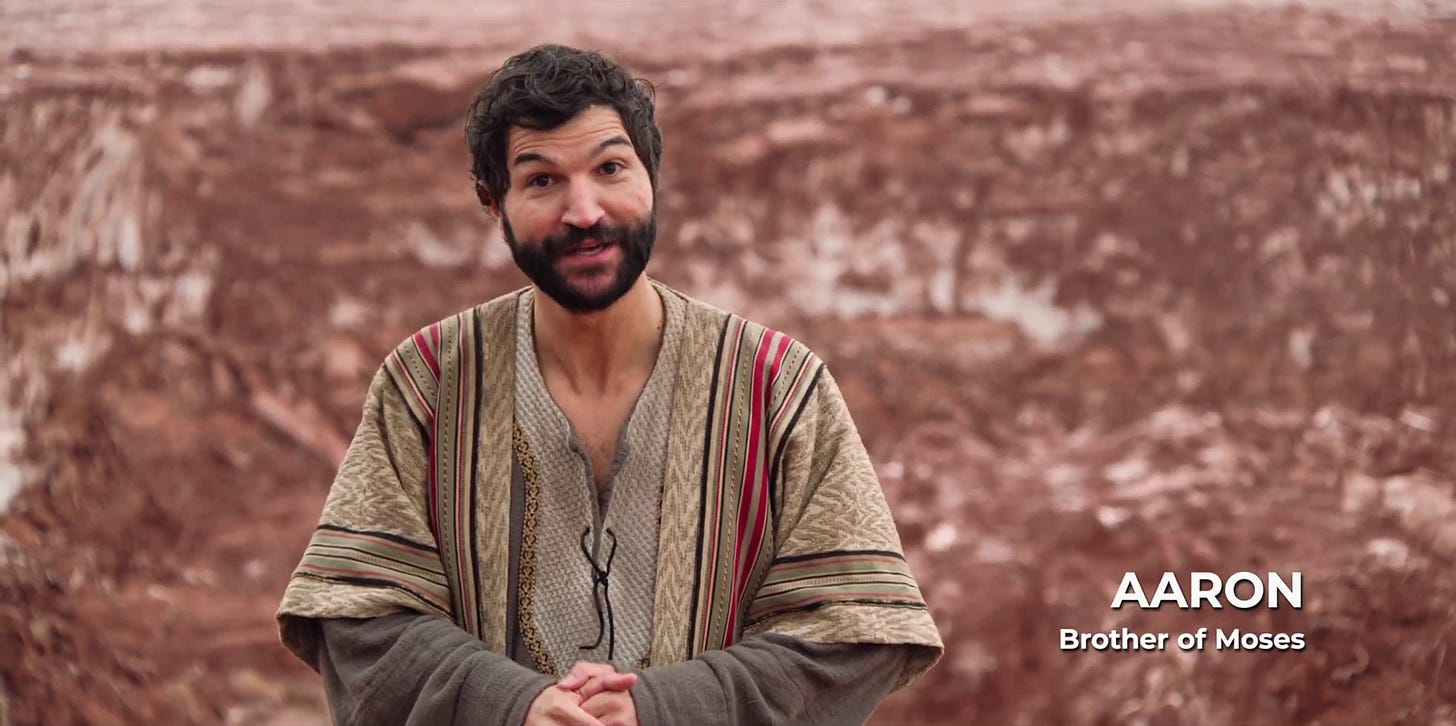The Promised Land – episode one
A scene-by-scene look at the biblical sources behind the new comedy about Moses leading the Israelites.

The Promised Land is an upcoming comedy series about Moses leading the Israelites, done in the style of a mockumentary like The Office or Parks and Recreation.
It currently consists of just one episode—a pilot you can watch on YouTube—but writer-director Mitch Hudson says he hopes to make forty episodes and a movie, and he’s going to start shooting the rest of the first season later this month.
Unlike some of the better-known Moses movies, which go straight from the crossing of the Red Sea to the giving of the Law at Mount Sinai,1 the first episode of The Promised Land takes place between those two points, and it covers some of the less-epic stories that aren’t filmed so often, as the Israelites adjust to the daily grind of their new life: trudging through the desert, gathering their food, fighting off attackers, and relying on Moses to resolve their disputes, however trivial they might be.
Along the way, the show finds plenty of opportunities for humour. Moses is frustrated by the pettiness of the Israelites’ complaints. His wife begins to get on his sister’s nerves. And an Egyptian tries to live among the Israelites incognito.
Believe it or not, there is actually a biblical basis for… well, not quite all of this, but certainly some of it. So I thought it might be fun to go through the episode scene-by-scene, and to tease out what the biblical sources for each bit might be.
The episode basically covers the events of Exodus 15-18, some of them in flashback: Moses leads the Israelites in song (15:1-21); the Israelites complain about some water being bitter (15:22-27); the Israelites gather manna and quail (16:1-36); Moses gets water from a rock (17:1-7); the Israelites fight off the Amalekites (17:8-16); and Moses receives a visit from his wife Zipporah and her father Jethro (18:1-27).
But there are lots of other passages that inform the episode, too. And there are some scenes that arguably contradict the biblical source material. So I figured I’d “fact-check” what I could, similar to the scene-by-scene breakdowns that I’ve done for films and TV shows both serious (Risen, The Young Messiah, Mary Magdalene, Paul, Apostle of Christ) and not-so-serious (History of the World Part II, Journey to Bethlehem).
If I missed anything, by all means, please let me know.
0:00-3:00 — The battle with the Amalekites
The episode begins with Aaron introducing himself as an Israelite from the tribe of Levi. A subtitle identifies him as the brother of Moses.
The biblical Aaron is identified as a Levite—a member of the tribe of Levi—in the very first passage that mentions him (Exodus 4:14). His parents are identified as Levites in the very first passage that mentions them, too (Exodus 2:1).
The family’s ancestry is spelled out in further detail in passages like Exodus 6:16-20 and I Chronicles 6:1-3: Levi was the father of Kohath, Kohath was the father of Amram, and Amram was the father of Aaron, Moses, and Miriam.
Notably, the genealogy in Exodus says Amram’s wife Jochebed was also the sister of Amram’s father. So Amram basically married his own aunt, and Moses and his siblings—including Aaron—were not merely from the tribe of Levi, they were also the grandchildren of Levi (on their mother’s side) and the great-grandchildren of Levi (on their father’s side). They were their own cousins, once removed.2
Aaron says the Israelites are in Rephidim, “just a few months’ travel east of the Red Sea.” In the background, we hear weapons clashing.
The biblical Israelites were attacked at Rephidim by the Amalekites (Exodus 17:8).
It did not take the Israelites multiple months to get to Rephidim from the Red Sea. For one thing, they passed through Rephidim on their way to Mount Sinai, and the entire journey from Egypt to Mount Sinai lasted only 45 days (note the start date in Numbers 33:3 and the end date in Exodus 19:1). Also, after the Israelites crossed the Red Sea, they returned to it—presumably further down the coast—and they camped there for a while before proceeding to Rephidim (Numbers 33:8-14). So when Aaron and the others got to Rephidim, it had probably been only a couple weeks, at most, since the last time they’d seen the Red Sea.3
For what it’s worth, Google Maps says it would take 83 hours to walk non-stop from the Ramesses district, which is where the Israelites had been living since Jacob’s day (Genesis 47:11; Exodus 1:11, 12:37; Numbers 33:3-5), to Firan, the traditional location of Rephidim. So if the Israelites had walked, say, eight hours a day, it would have been a ten- or eleven-day trip. But I assume a group of hundreds of thousands of people—with livestock!—would have moved much, much slower than that. So a trip of thirty to forty days makes sense.

Aaron says, “I am sure we’ll reach the Promised Land in no time.”
Heh. Who wants to tell him?
The biblical Israelites actually got to the edge of the Promised Land only a year or two after they left Egypt.4 But then they sent spies into the Promised Land and became afraid of what they found there—so God condemned them to forty years of wandering in the wilderness, which may or may not have included the time they’d already spent on the road (Numbers 14:33-34).
Aaron himself never got to the Promised Land, as he died near the end of the forty years of wandering (Numbers 20:22-29, 33:38-39).
Keep reading with a 7-day free trial
Subscribe to Thoughts and Spoilers to keep reading this post and get 7 days of free access to the full post archives.



